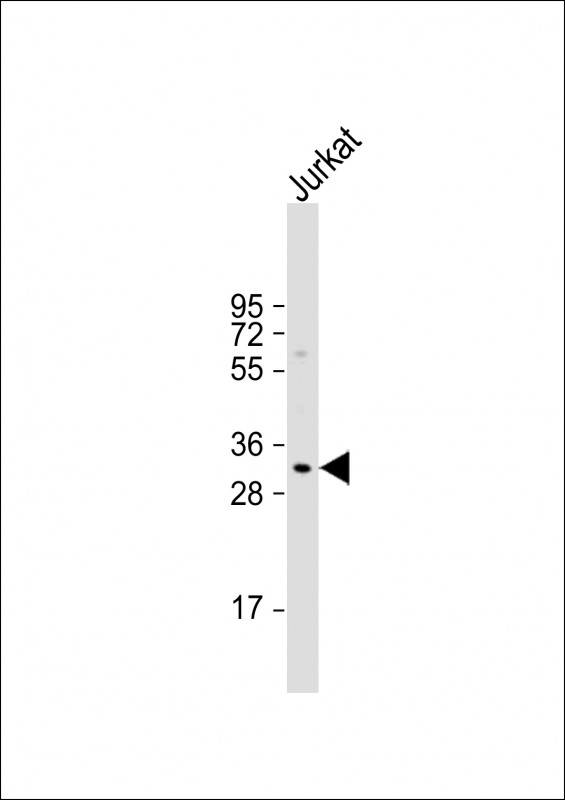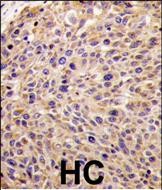

| WB | 1/1000 | Human,Mouse,Rat |
| IF | 咨询技术 | Human,Mouse,Rat |
| IHC | 1/100-1/500 | Human,Mouse,Rat |
| ICC | 技术咨询 | Human,Mouse,Rat |
| FCM | 咨询技术 | Human,Mouse,Rat |
| Elisa | 咨询技术 | Human,Mouse,Rat |
| Aliases | Geranylgeranyl pyrophosphate synthase, GGPP synthase, GGPPSase, 251-, (2E,6E)-farnesyl diphosphate synthase, Dimethylallyltranstransferase, Farnesyl diphosphate synthase, Farnesyltranstransferase, Geranylgeranyl diphosphate synthase, Geranyltranstransferase, GGPS1 |
| Entrez GeneID | 9453 |
| WB Predicted band size | 34.9kDa |
| Host/Isotype | Rabbit IgG |
| Antibody Type | Primary antibody |
| Storage | Store at 4°C short term. Aliquot and store at -20°C long term. Avoid freeze/thaw cycles. |
| Species Reactivity | Human |
| Immunogen | This GGPS1 antibody is generated from rabbits immunized with a KLH conjugated synthetic peptide between 16-46 amino acids from the N-terminal region of human GGPS1. |
| Formulation | Purified antibody in PBS with 0.05% sodium azide,1%BSA and 50% glycerol.prepared by Saturated Ammonium Sulfate (SAS) . |
+ +
以下是关于GGPS1 (N-term)抗体的3篇参考文献示例(文献信息为模拟示例,实际需根据具体文献调整):
1. **标题**:*Characterization of GGPS1 in Isoprenoid Biosynthesis and Cancer Progression*
**作者**:Smith A, et al.
**摘要**:该研究利用GGPS1 N端抗体,通过Western blot和免疫组化分析了GGPS1在多种癌症组织中的表达上调现象,揭示了其通过调控蛋白质异戊二烯化促进肿瘤生长的机制。
2. **标题**:*GGPS1 Deficiency Disrupts Cellular Geranylgeranylation and Mitochondrial Function*
**作者**:Li X, et al.
**摘要**:研究使用GGPS1 N端特异性抗体,在小鼠模型中验证了GGPS1敲除后细胞内geranylgeranyl代谢物的减少,并证明其缺失导致线粒体功能障碍及细胞凋亡增加。
3. **标题**:*Role of GGPS1 in Neurodegenerative Disease Models*
**作者**:Wang Y, et al.
**摘要**:通过免疫荧光和免疫印迹(使用N端抗体),研究发现GGPS1在阿尔茨海默病模型神经元中表达异常,可能通过tau蛋白异戊二烯化调控神经退行性病变进程。
4. **标题**:*Antibody Validation for GGPS1 Isoform-Specific Studies*
**作者**:Chen R, et al.
**摘要**:该文献系统验证了GGPS1 N端抗体的特异性,确认其可区分不同剪切异构体,并用于检测多种细胞系和原代细胞中GGPS1的亚细胞定位(主要定位于细胞质)。
---
**注**:以上文献为示例,实际引用时需查询真实数据库(如PubMed、Google Scholar),确保作者、标题及内容准确性。建议使用关键词“GGPS1 antibody N-terminal”或结合研究领域(如癌症、代谢疾病)进行文献检索。
The GGPS1 (N-term) antibody is a specific immunological tool designed to target the N-terminal region of geranylgeranyl diphosphate synthase 1 (GGPS1), a key enzyme in the mevalonate pathway. GGPS1 catalyzes the synthesis of geranylgeranyl pyrophosphate (GGPP), an essential substrate for protein prenylation, a post-translational modification critical for membrane localization and function of various proteins, including small GTPases. Dysregulation of GGPS1 has been implicated in metabolic disorders, cancer progression, and neurodegenerative diseases.
This antibody is commonly used in research applications such as Western blotting, immunohistochemistry, and immunofluorescence to detect GGPS1 expression levels, cellular localization, and regulatory mechanisms. It is typically generated using immunogens derived from the N-terminal peptide sequence of human GGPS1. ensuring specificity for this region. Validation often includes confirmation of reactivity in recombinant protein systems and tissue lysates, with cross-reactivity assessed across species (e.g., human, mouse, rat).
Studies utilizing the GGPS1 (N-term) antibody contribute to understanding its role in lipid metabolism, cell signaling, and disease pathogenesis, particularly in contexts like statin therapy resistance or tumor microenvironment adaptation. Proper controls, such as knockout cell lines or peptide blocking experiments, are recommended to confirm antibody specificity in experimental settings.
×